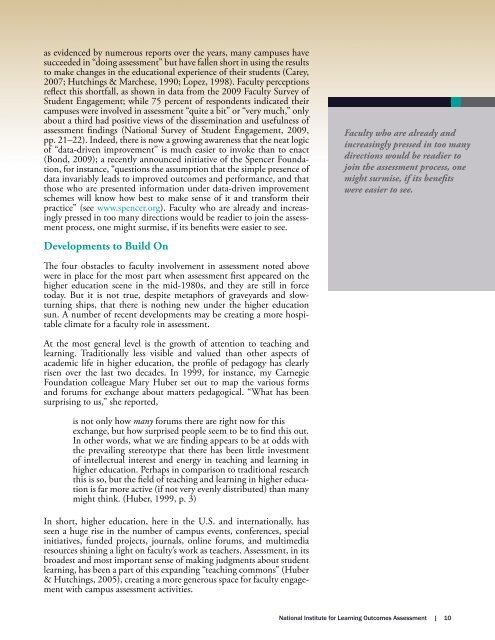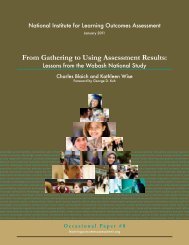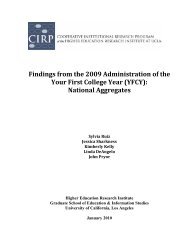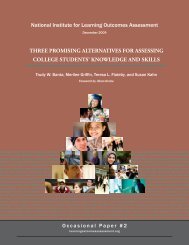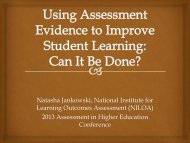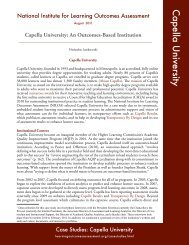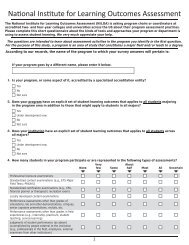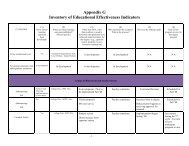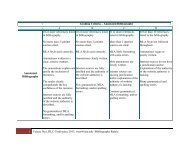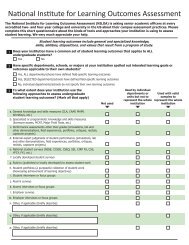Opening Doors to Faculty Involvement in Assessment - National ...
Opening Doors to Faculty Involvement in Assessment - National ...
Opening Doors to Faculty Involvement in Assessment - National ...
Create successful ePaper yourself
Turn your PDF publications into a flip-book with our unique Google optimized e-Paper software.
as evidenced by numerous reports over the years, many campuses have<br />
succeeded <strong>in</strong> “do<strong>in</strong>g assessment” but have fallen short <strong>in</strong> us<strong>in</strong>g the results<br />
<strong>to</strong> make changes <strong>in</strong> the educational experience of their students (Carey,<br />
2007; Hutch<strong>in</strong>gs & Marchese, 1990; Lopez, 1998). <strong>Faculty</strong> perceptions<br />
reflect this shortfall, as shown <strong>in</strong> data from the 2009 <strong>Faculty</strong> Survey of<br />
Student Engagement; while 75 percent of respondents <strong>in</strong>dicated their<br />
campuses were <strong>in</strong>volved <strong>in</strong> assessment “quite a bit” or “very much,” only<br />
about a third had positive views of the dissem<strong>in</strong>ation and usefulness of<br />
assessment f<strong>in</strong>d<strong>in</strong>gs (<strong>National</strong> Survey of Student Engagement, 2009,<br />
pp. 21–22). Indeed, there is now a grow<strong>in</strong>g awareness that the neat logic<br />
of “data-driven improvement’’ is much easier <strong>to</strong> <strong>in</strong>voke than <strong>to</strong> enact<br />
(Bond, 2009); a recently announced <strong>in</strong>itiative of the Spencer Foundation,<br />
for <strong>in</strong>stance, “questions the assumption that the simple presence of<br />
data <strong>in</strong>variably leads <strong>to</strong> improved outcomes and performance, and that<br />
those who are presented <strong>in</strong>formation under data-driven improvement<br />
schemes will know how best <strong>to</strong> make sense of it and transform their<br />
practice” (see www.spencer.org). <strong>Faculty</strong> who are already and <strong>in</strong>creas<strong>in</strong>gly<br />
pressed <strong>in</strong> <strong>to</strong>o many directions would be readier <strong>to</strong> jo<strong>in</strong> the assessment<br />
process, one might surmise, if its benefits were easier <strong>to</strong> see.<br />
Developments <strong>to</strong> Build On<br />
<strong>Faculty</strong> who are already and<br />
<strong>in</strong>creas<strong>in</strong>gly pressed <strong>in</strong> <strong>to</strong>o many<br />
directions would be readier <strong>to</strong><br />
jo<strong>in</strong> the assessment process, one<br />
might surmise, if its benefits<br />
were easier <strong>to</strong> see.<br />
The four obstacles <strong>to</strong> faculty <strong>in</strong>volvement <strong>in</strong> assessment noted above<br />
were <strong>in</strong> place for the most part when assessment first appeared on the<br />
higher education scene <strong>in</strong> the mid-1980s, and they are still <strong>in</strong> force<br />
<strong>to</strong>day. But it is not true, despite metaphors of graveyards and slowturn<strong>in</strong>g<br />
ships, that there is noth<strong>in</strong>g new under the higher education<br />
sun. A number of recent developments may be creat<strong>in</strong>g a more hospitable<br />
climate for a faculty role <strong>in</strong> assessment.<br />
At the most general level is the growth of attention <strong>to</strong> teach<strong>in</strong>g and<br />
learn<strong>in</strong>g. Traditionally less visible and valued than other aspects of<br />
academic life <strong>in</strong> higher education, the profile of pedagogy has clearly<br />
risen over the last two decades. In 1999, for <strong>in</strong>stance, my Carnegie<br />
Foundation colleague Mary Huber set out <strong>to</strong> map the various forms<br />
and forums for exchange about matters pedagogical. “What has been<br />
surpris<strong>in</strong>g <strong>to</strong> us,” she reported,<br />
is not only how many forums there are right now for this<br />
exchange, but how surprised people seem <strong>to</strong> be <strong>to</strong> f<strong>in</strong>d this out.<br />
In other words, what we are f<strong>in</strong>d<strong>in</strong>g appears <strong>to</strong> be at odds with<br />
the prevail<strong>in</strong>g stereotype that there has been little <strong>in</strong>vestment<br />
of <strong>in</strong>tellectual <strong>in</strong>terest and energy <strong>in</strong> teach<strong>in</strong>g and learn<strong>in</strong>g <strong>in</strong><br />
higher education. Perhaps <strong>in</strong> comparison <strong>to</strong> traditional research<br />
this is so, but the field of teach<strong>in</strong>g and learn<strong>in</strong>g <strong>in</strong> higher education<br />
is far more active (if not very evenly distributed) than many<br />
might th<strong>in</strong>k. (Huber, 1999, p. 3)<br />
In short, higher education, here <strong>in</strong> the U.S. and <strong>in</strong>ternationally, has<br />
seen a huge rise <strong>in</strong> the number of campus events, conferences, special<br />
<strong>in</strong>itiatives, funded projects, journals, onl<strong>in</strong>e forums, and multimedia<br />
resources sh<strong>in</strong><strong>in</strong>g a light on faculty’s work as teachers. <strong>Assessment</strong>, <strong>in</strong> its<br />
broadest and most important sense of mak<strong>in</strong>g judgments about student<br />
learn<strong>in</strong>g, has been a part of this expand<strong>in</strong>g “teach<strong>in</strong>g commons” (Huber<br />
& Hutch<strong>in</strong>gs, 2005), creat<strong>in</strong>g a more generous space for faculty engagement<br />
with campus assessment activities.


